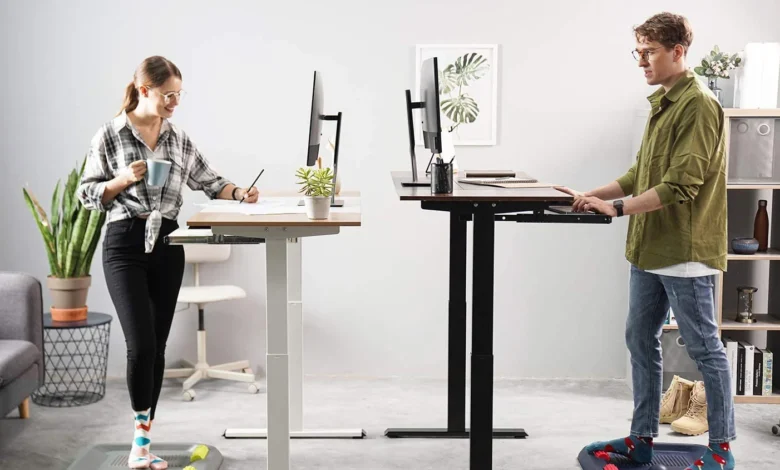What’s the ideal sitting and standing desk ratio?

With the rise of the tech-savvy, modern office, there has been a shift away from traditional office furniture such as sitting desks and towards ergonomic, standing desks. As our understanding of the importance of physical health in the workplace has grown, the ideal ratio between sitting and standing desks has become a topic of much debate. While some prefer the traditional desk-based office, the potential health benefits of standing desks have led to increased popularity in the last decade. But what is the best ratio between sitting and standing desks? To answer this question, we must first look at the advantages of each type of desk.
In recent years, standing desks and sitting desks have both become popular options for those looking to improve their physical and mental well-being, posture, and energy levels. While the two types of desks may seem similar, they provide different benefits and can be used in different ways.
When it comes to standing desks, the primary advantage is that they allow you to alternate between sitting and standing throughout the day. This helps to keep your body active and engaged and can help prevent the development of back and neck pain. Standing desks can also help to improve posture as they force you to stand up straight. Additionally, standing desks can help to increase energy and focus as they encourage more movement and less sedentary behaviour.
Sitting desks, on the other hand, provide a more traditional workspace. They are best for those who prefer to stay in one position for extended periods of time. Sitting desks can help to improve posture as they are designed to keep your spine in an upright position. They also help to reduce fatigue as they provide a comfortable and stable surface for working.
Finding the perfect balance between sitting and standing at your desk can be tricky, but it has been proven to be beneficial to health and productivity. The ideal sitting and standing desk ratio will depend on the individual and the type of work being done. However, it is recommended to alternate between standing and sitting around every 30 minutes to an hour throughout the day. Doing so can help encourage an array of health benefits such as better posture, higher energy levels, and many more associated with increased activity throughout the day.
When sitting, make sure you adjust your ergonomic office chair to the correct height for your body. Your feet should be flat on the floor and your knees should be level with your hips. Ensure your back is properly supported and your arms are at a 90-degree angle when typing or using a mouse. If your job involves a lot of data entry, it’s a good idea to use an ergonomically designed keyboard and mouse.
When at a standing desk, it’s important to maintain good posture. Stand tall and keep your shoulders back, not relaxed and hunched. Your monitor should be set at eye level and the keyboard slightly below the screen so that your wrists remain straight. Sitting can also create strain on your feet and back. To combat this you can try some cool desk accessories like an anti-fatigue mat, also known as a footrest, as these have been shown to reduce strain in those areas.
It’s also important to remember to take breaks throughout the day. Take a short walk around the office or outside every hour or so, or simply stand up and stretch for a few minutes. Doing this will help to reduce the strain on your body and keep you energised.
Generally speaking, the ideal ratio between sitting and standing throughout the day will depend on the individual and the type of work they are doing. Nonetheless, it is important to alternate between sitting and standing every 30 minutes to an hour throughout the day and ensure that your desk is set up ergonomically for both standing and sitting. This can help reduce the risk of developing physical issues and keep you productive and active throughout the day.
By 2033, the workplace will likely look very different from what it is today, with a greater focus on ergonomics and health, as well as the use of technology to improve productivity.
Ultimately, deciding which type of desk is best for you will come down to your individual needs and preferences. Both standing and sitting desks provide advantages and can be used to improve physical and mental well-being, posture, and energy levels.
Read here more about this website for more information.




